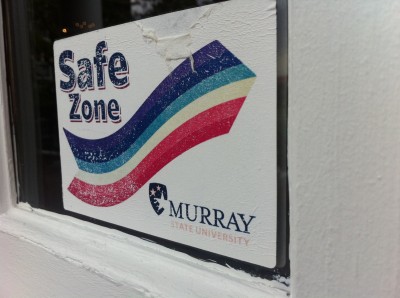
There was not always an outlet available for students to share personal concerns, such as sexuality, but now Murray State offers the Safe Zone Project for students.
The Safe Zone Project is a national program promoting non-discrimination and gives students a safe haven to go for assistance. Jody Cofer, Lesbian Gay Bisexual Transgender (LGBT) program coordinator and undergraduate research and scholarly activities program coordinator, and Dr. Josh Adair, assistant professor of English, are the leaders of the project.
“The Safe Zone Project emerged between 2009 and 2010 and it emerged from a group of students that wanted to do something specifically to raise awareness among allies, specifically faculty and staff allies,” Cofer said.
Students can go to any Safe Zone throughout campus to get assistance from a faculty member about an issue.
“It is really promoting a campus that is inclusive of everyone no matter whatever that difference may be and we’re starting to go there with the Safe Zone Project to really say that this is about difference and about empowering difference,” Cofer said.
Judy Lyle, interim association director for health services, serves on the LGBT program advisory committee. She makes sure that students know they have a place to go to when they need comfort.
“The most important thing from my perspective is that any student has a place that they can go talk and feel like they can be open about any issue whether it be about their orientation, their color, culture whatever and they can get the proper help that they need in answer to their questions,” Lyle said.
A Safe Zone manual was also created for participants to use as a guide when advising students.
“In the resource manual there is a section on common problems that allies might get faced with such as the coming out process, problems with parents, transgender people, dealing with faculty that aren’t supportive,” Cofer said.
Michael Penner, sophomore from Cynthiana, Ind., is vice president of the Murray State Alliance. He hopes more places on campus will get their area set up for a Safe Zone.
“Hopefully once the faculty and staff see that we have over 225 members in the project, we are hoping that more will get on board and join so that they can have a Safe Zone too,” Penner said.
Students and faculty can register anytime to become a member by filling out an online form and agreeing to the affirmation statement on the Safe Zone page at murraystate.edu/lgbt.
“When we receive those online submissions, the applicant gets a letter welcoming them, directing them to the resources, encouraging training, they get the emblem itself in campus mail and they are instructed to put that somewhere in a visible location,” Cofer said.
There will be a free training session for Safe Zone participants at 1:30 p.m. Sept. 28 in Faculty Hall rooms 105 and 106. Special guest Nora Spencer from Vanderbilt University will be speaking about the project.
“People in the Safe Zone project do not have to go to training, but it is recommended; it’s a resource for them,” Cofer said.
The list of faculty members registered is published on the Safe Zone website.
Students can find a Safe Zone by looking for an emblem posted on or around a faculty member’s door. The emblem has the words Safe Zone, a Murray State University Logo and a rainbow (as seen above).
For more information on the project or to download the Safe Zone resource manual, visit murraystate.edu/lgbt.
Story by Dominique Duarte, Contributing writer.